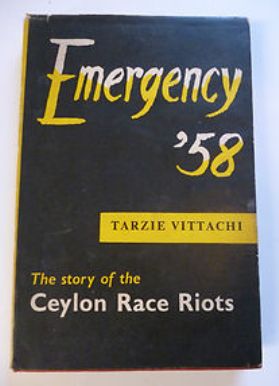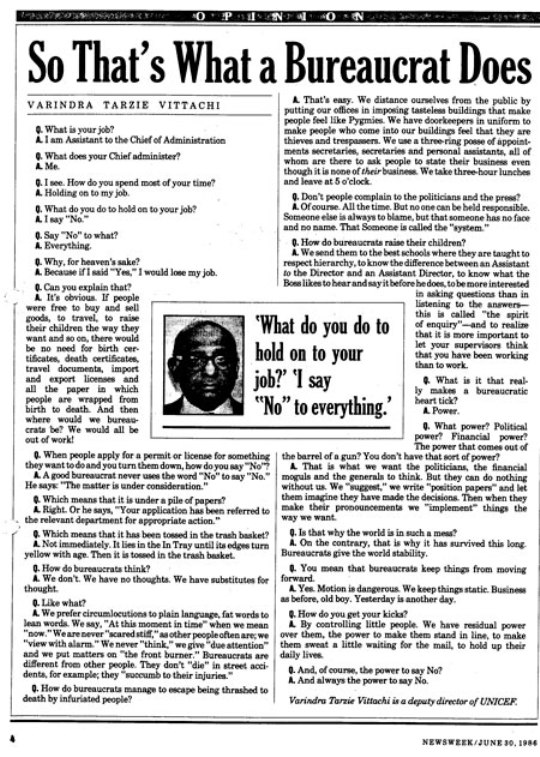My weekend column in Ravaya newspaper (in Sinhala) is devoted this week to remember the illustrious Lankan journalist, editor and development communicator, Tarzie Vitachi (1921 – 1993).
See also: සිවුමංසල කොලූගැටයා #114: ටාසිගේ ලෝකය හා මගේ ලෝකය

නිව්ස්වීක් සඟරාව මුඵමනින් ඩිජිටල්කරණය වීම ගැන 2013 ජනවාරි 27දා කොලමින් කථා කරද්දී කලක් එයට කොලම් ලියූ කීර්තිමත් ලාංකික පත්ර කලාවේදී ටාසි විට්ටච්චිගේ (Tarzie Vittachi) හපන්කම් ගැන මා සඳහන් කළා.
කවුද මේ ටාසි විට්ටච්චි?
1921-1993 කාල වකවානුවේ ජීවත් වූ ඔහු 1959දී විදේශ ගත වීම නිසා පරම්පරා කිහිපයක මෙරට පාඨකයන් ඔහු හදුනන්නේ නැහැ. විශෙෂයෙන් ම සිංහල පාඨකයන් අතර ඔහුගේ නම පවා ආගන්තුකයි.
සමහරුන්ට ටාසි ගැන ඇත්තේ වැරදි වැටහීමක්. 1956 සමාජ පෙරලියට අනුගත වන්නට නොහැකි හෝ නොකැමති හෝ වූවකු හැටියට. මා දන්නා තරමට නම් ටාසිට පක්ෂ දේශපාලනයක් තිබුණේ නැහැ. එහෙත් අදීන පුවත්පත් කතුවරයකු හා මාධ්ය ලේඛකයකු හැටියට දශකයකට වැඩි කාලයක් ශී්ර ලංකාවේත්, ඉනික්බිති දශක තුනකට වඩා ජාත්යන්තර තලයේත් කි්රයා කළ ඔහු, මගේ වීරයෙක්.
එසේ කියන්නේ ඇයි?
මා ඔහු මුණ ගැසී ඇත්තේ ඔහුගේ ජීවිතයේ අවසාන කාලයේ කිහිප වතාවක් පමණයි. එහෙත් ඔහු සමඟ එකට වැඩ කළ හා ඔහුගෙන් පුහුණුව හා ප්රබෝධක ආවේගය (inspiration) ලද බොහෝ දෙනකු ලොව පුරා මට හමු වී තිබෙනවා. ඔවුන් ඔහු ගැන තවමත් කථා කරන්නේ ගුරු දෙවියකු බදු ගෞරවාදරයෙන්.
ව්යක්ත ලෙස ඉංගී්රසි බස හැසිරවීමේ හැකියාව නිසා අපේ දුපතෙන් ඔබ්බට වෘත්තීය නිම්වළලූ පුඵල් කරගත් ලාංකික පුවත්පත් කලාවේදීන් ගණනාවක් විසිවන සියවසේ සිටියා. ඔවුන් සමහරෙක් සිංගප්පුරුව, තායිලන්තය, හොංකොං හා මැදපෙරදිග රටවල ඉංගී්රසි පුවත්පත්වල කර්තෘ මණ්ඩල තනතුරු දැරුවා. තවත් සමහරුන් ජාත්යන්තර පුවත් සේවාවල හෝ පුවත් සඟරාවල ලාංකික වාර්තාකරුවන් ලෙස හපන්කම් කළා. මේ අය අතර ප්රමුඛ චරිත දෙකක් නම් ඩෙන්සිල් පීරිස් (1917 – 1985) හා ටාසි විට්ටච්චි.
අභය ගාමිණී පෙරේරා ‘ටාසි’ විට්ටච්චි 1921දී කොළඹ උපත ලැබුවා. ගුරුවරුන් වූ ඔහුගේ දෙමවුපියෝ කුඩා වියේ පටන් හැම දෙයක් ගැන ම ප්රශ්න කරන්නට හා ස්වාධීනව සිතන්නට අනුබල දුන්නා. කොළඹ ආනන්ද විද්යාලයෙන් ප්රාථමික හා ද්වීතියික අධ්යාපනය ලැබු ඔහු 1944දී ලංකා විශ්ව විද්යාලයෙන් ආර්ථීක විද්යාව හා දේශපාලන විද්යාව ගැන උපාධියක් ලබා ගත්තා.
ගුරු වෘත්තියේ හා බැංකු ක්ෂෙත්රයේ වසර කිහිපයක් රැකියාව කිරීමෙන් පසු 1950දී ඔහු (පෞද්ගලික සමාගමක්ව පැවති) ලේක්හවුසියේ සේවයට ගියේ ඬේලි නිවුස් පත්රයේ සහකාර කතුවරයකු හැටියට. කෙටි කලකින් පාඨකයන් අතර ජනාදරයට පත් කොලම් (තීරු ලිපි) දෙකක් ඔහු ඇරඹූවා. Cursory Glances නම් එකකින් ඔහු රජයේ දුෂණ හා පරිපාලන අක්රමිකතා හෙළි කළා. Bouquets & Brickbats නම් අනෙක, උපහාසාත්මකව ලක් සමාජයේ පැතිකඩ විග්රහ කළා.
ලොකු පොඩි කාහටත් සරදම් කිරීමට සහජ හැකියාවක් ටාසිට තිබුණා. ඔහු ලීවේ Fly by Night යන ආරූඪ නමින් වුවත් එය පිටුපස සිටින ලේඛකයා කවුද යන්න බොහෝ දෙනා දැන සිටියා. ඔහුගේ කුසලතා නිසා 1953දී Ceylon Observer පත්රයේ ප්රධාන කතුවරයා ලෙස පත් කරනු ලැබුවා. ආසියාවේ පැරණිතම ඉංගී්රසි පත්රයේ ලාබාල ම කතුවරයා වන විට ඔහුගේ වයස 32යි.
බි්රතාන්ය පාලකයන්ගෙන් මෙරට රාජ්යකරණය භාර ගත් දේශීය පාලකයන්, සිය ඡන්දදායකයන්ට හා සමස්ත පුරවැසියන්ට මුඵමනින් වගකිව යුතු බවත්, ඒ සඳහා මාධ්ය විසින් පාලකයන්ට දිනපතා බලපෑම් කළ යුතු බවත් ටාසිගේ මාධ්ය කලාවේ මුලික සාරධර්මය වුණා. මෑතදී නිදහස ලැබූ රටෙහි සුවහසක් පැතුම් දේශපාලන මඩ ගොහොරුවේ ගිලී යා නොදී බේරා ගත යුතු බව ඔහු විශ්වාස කළා.
1950 දශකය පුරා අගමැතිවරුන් සිවු දෙනකුගේ පාලන යුගයන් තුළ ඔහු පවතින රජයන් දැඩි විමර්ශනයට හා විවේචනයට ලක් කළා. ලේක්හවුසියේ හිමිකරුවන්ගේ දේශපාලන නැඹුරුව හා මෙරට වරප්රසාද ලත් ‘බමුණු කුලයේ’ අවශ්යතා නියෝජනය කළා යයි ඇතැම් දෙනා ටාසිට චෝදනා කළත් ඔහුගේ ලාංකික මාධ්ය කාර්ය භාරය තුලනාත්මක ඇගැයීමකට ලක් වී නැති බව මගේ හැගීමයි.
 1958 මැයි මාසයේ ඇති වූ සිංහල-දෙමළ වාර්ගික ගැටුම් ගැන පත්ර කලාවේදියකුගේ වාර්තාකරණය ඇතුළත් කොට ටාසි Emergency ’58: The Story of the Ceylon Race Riots නම් ඉංගී්රසි පොත රචනා කළා. සිදුවීම්වලින් මාස කිහිපයක් ඇතුළත එළි දුටු මේ පොත මහත් ආන්දෝලනයක් ඇති කළා. පක්ෂ දේශපාලනයෙන් තොරව ජාතික මට්ටමින් සිදුවීම් හා එයට තුඩු දුන් ඓතිහාසික, සමාජයීය හා දේශපාලනික සාධක විග්රහ කළ ටාසි යළි යළිත් කියා සිටියේ ගෝති්රක බෙදීම් හා කුලල් කා ගැනීම් ඉක්මනින් පාලනය කර නොගතහොත් ලංකාව ප්රචණ්ඩත්වයේ හා අස්ථාවර බවෙහි ගිලී යනු ඇති බවයි.
1958 මැයි මාසයේ ඇති වූ සිංහල-දෙමළ වාර්ගික ගැටුම් ගැන පත්ර කලාවේදියකුගේ වාර්තාකරණය ඇතුළත් කොට ටාසි Emergency ’58: The Story of the Ceylon Race Riots නම් ඉංගී්රසි පොත රචනා කළා. සිදුවීම්වලින් මාස කිහිපයක් ඇතුළත එළි දුටු මේ පොත මහත් ආන්දෝලනයක් ඇති කළා. පක්ෂ දේශපාලනයෙන් තොරව ජාතික මට්ටමින් සිදුවීම් හා එයට තුඩු දුන් ඓතිහාසික, සමාජයීය හා දේශපාලනික සාධක විග්රහ කළ ටාසි යළි යළිත් කියා සිටියේ ගෝති්රක බෙදීම් හා කුලල් කා ගැනීම් ඉක්මනින් පාලනය කර නොගතහොත් ලංකාව ප්රචණ්ඩත්වයේ හා අස්ථාවර බවෙහි ගිලී යනු ඇති බවයි.
වාර්ගික බෙදීම් ඇති රටක ඇති-නැති පරතරය දැඩි ලෙස පැවතීම ගැටුම් ඇති කිරීමේ හැකියාව වඩාත් තීව්ර කරන බවත්, දුගී බව හා විරැකියාව සැළකිය යුතු අන්දමින් අඩු කිරීමේ ප්රබල අභියෝගයට ලක් රජයන් මුහුණ දිය යුතු බවත් ඔහු අවධාරණය කළා.
සමාජයීය විපර්යාසයන් සීඝ්රගාමීව සිදු වන කාලයක නීතියේ ආධිපත්යය (Rule of Law) නොකෙලෙසී පවත්වා ගැනීම අත්යවශ්ය බවත්, ගැටුම් හා හදිසි අවස්ථාවල පවා පාලකයන්ට පැවරෙන බලය පාර්ලිමේන්තු හා අධිකරණ අධීක්ෂණයට නතු විය යුතු බවත් මේ පොතෙන් හා සිය මාධ්යකරණයෙන් ටාසි තර්ක කළා.
පුවත්පත් කතුවරයකු මෙලෙස ස්වාධීනව හා නිර්භයව අදහස් පළ කිරීම එවක රජයන්ට අභියෝගයක් වුණා. අද මෙන් එදාත් පණිවුඩයේ වැදගත්කමට වඩා පක්ෂ දේශපාලනය ඉස්මතු කරනු ලැබුවා. මහජන ඡුන්දයෙන් පත් වූ ජනතා රජයකට මෙසේ අභියෝග කරන්නට පත්තරකාරයකුට අයිතියක් නැතැයි රජයේ වන්දිභට්ටයෝ කියා සිටියා!
ජනතාවාදී යයි කියා ගන්න රජයක අඩුපාඩුකම්, ප්රතිපත්තිමය දුර්වලතා සහ පරිපාලන අක්රමිකතා පෙන්වාදීමට මාධ්යවේදීන්ට අයිතියක් මෙන් ම වගකීමක් ද තිබෙනවා. ටාසි හා ඔහුගේ සමකාලීන ස්වාධීන චින්තකයන් මීට අඩසියවසකට පෙර කළ අනතුරු ඇඟවීම් ගැන ලක් සමාජය මීට වැඩි අවධානයක් යොමු කළා නම් අපේ මෑත ඉතිහාසය බෙහෙවින් වෙනස් වන්නට ඉඩ තිබුණා.
1959 අගෝස්තු මාසයේ පිලිපීනයේ මැනිලා නුවරදී පත්රකලාව හා සාහිත්යය සඳහා වන රේමන් මැග්සායිසායි ත්යාගය (ආසියාවේ නොබෙල් ත්යාගය) ටාසිට පිරිනමනු ලැබුවා. ඒ වසරේ ත්යාගය බුරුමයේ ‘ද නේෂන්’ පුවත්පත ආරම්භක කර්තෘ එඞ්වඞ් මයිකල් ලෝ යෝන් (Edward Michael Law Yone) හා ටාසි විට්ටච්චි අතර සමසේ බෙදුණා.
හේතු පාඨයෙන් කියැවුණේ මෑතදී නිදහස ලැබු මේ දෙරටේ ප්රජාතන්ත්රවාදය හා යහපාලනය සවිමත් කරන්නට තර්ජන ගර්ජන නොතකා අදීනව හා අභීතව කි්රයා කිරීම නිමිත්තෙන් ත්යාගය පිරිනමන බවයි. (මැග්සායිසායි සම්මානය ලැබූ දෙවැනි ලාංකිකයා වූයේ ටාසියි. ගෙවී ගිය 54 වසර තුළ එය ලාංකිකයන් 9 දෙනෙකුට හිමි වී තිබෙනවා.)
ස්වාධීන මතධාරීවීම හා අදීනව වෘත්තිමය කටයුතු කිරීම නිසා ඇති වූ දැඩි බලපෑම් හමුවේ රට හැර ගිය මුල් ම ලාංකික පත්රකලාවේදියා ටාසි ද? මෙයට නිශ්චිත පිළිතුරක් මට නැතත්, 1959දී ටාසි හදිසියේ ම විදේශගත වුණා.
1960-65 කාලයේ මැලේසියාවේ ක්වාලා ලම්පුර් නුවර ජාත්යන්තර පුවත්පත් ආයතනයේ (International Press Institute)ආසියානු අධ්යක්ෂවරයා ලෙසත්, ඉනික්බිති පිලිපීනයේ මැනිලා නුවර පිහිටි ආසියානු පුවත්පත් පදනමේ (Press Foundation of Asia) සමාරම්භක අධ්යක්ෂවරයා ලෙසත් කි්රයා කළා. ඔහු නිත්ය පදිංචියට බි්රතාන්යයට ගියේ 1970 දශකයේයි. 1971-72 කාලයේ ලන්ඩනයෙන් පළ කළ The Asian ප්රකාශනයේ ප්රධාන කතුවරයා වුණා.
මීට අමතරව ලන්ඩනයේ Sunday Times පත්රයට හා The Economist පුවත් සඟරාවටත්, BBC රේඩියෝවටත් විශේෂ වාර්තාකරුවකු ලෙස 1965-1972 කාලයේ ඔහු දායකත්වය දුන්නා. මෙකී නොකී සැම තැනකදී ම ඔහු උත්සාහ කළේ (එවකට බහුලව තුන්වන ලෝකය යයි හදුන්වනු ලැබූ) ආසියාවේ, අපි්රකාවේ හා ලතින් අමෙරිකාවේ දියුණු වන රටවල ජනයාගේ සිතුම් පැතුම්, ආකල්ප හා ප්රශ්න බටහිර දියුණු රටවල පාඨකයන්ගේ හා පාලකයන්ගේ අවධානයට ලක් කරන්නයි.
අමෙරිකාව හා සෝවියට් දේශය අතර සීතල යුද්ධයේ උච්චතම අවධියේ ලොව හැම ප්රශ්නයක් ම ධනවාදය හා සමාජවාදය/කොමියුනිස්ට් චින්තනය අතර අරගලයක් බවට ලඝු කරන්නට බොහෝ චින්තකයන් හා මාධ්යවේදීන් උත්සාහ කළා. ටාසි වැනි කිහිප දෙනෙක් කියා සිටියේ මේ න්යායාත්මක් විග්රහයෙන් ඔබ්බට යන, සමාජ සාධාරණත්වය හා ආචාරධර්ම මත පදනම් වූ දැක්මක් අවශ්ය බවයි.
1970-1980 දශකයන්ගේ බොහෝ බටහිර මාධ්ය ආයතන සමස්ත තුන්වන ලෝකය ම මතුපිටින් හා සරලව වාර්තා කළේ අන්ත දිළිදු බව, සමාජ විසමතා, දේශපාලන අස්ථාවර බව හා ගැටුම්වලින් පිරි මහා කාලකන්නි ලෝකයක් හැටියටයි. අපට බරපතල ප්රශ්න ඇතත්, ඒවාට විසදුම් ද තිබෙන බවත්, රටවල් අතර මෙන් ම රටවල් තුළත් අති විශාල විවිධත්වයක් පවතින බවත්, සියඵ තෙවන ලොව රටවල් එක අච්චුවකට දමා විග්රහ කිරීම මුඵමනින් ම වැරදි බවත් ඔහු පෙන්වා දුන්නා.
ටාසි මේ සන්නිවේදනය කළේ ආවේගශීලිව, උද්යොග පාඨ සහිතව ලිවීමෙන් නොවෙයි. ඉතා සංවරව, සංවාදශීලිව හා බොහෝ විට හාස්යය හා උපහාසය මුසුකර ගනිමින්. ඔහු මුල් යුගයේ ජාත්යන්තර ප්රකාශනවලට ලියූ ලිපි දැන් සොයා ගැනීම අපහසු වුවත් 1980 දශකය පුරාම Newsweek සඟරාවට ලියූ තීරු ලිපි මෙකී සරල, සුගම හා රසබර ශෛලියෙන් නිමැවුණු බව මට මතකයි.
ලිබරල් ප්රජාතන්ත්රවාදී ක්රමයට නැඹුරු වූ බටහිර රටවල, නිල රාජ්ය ප්රතිපත්තියට කිසිසේත් අනුගත නොවූ ස්වාධීන මතධාරී විද්වතුන්, පර්යේෂකයන් හා සමාජ කි්රයාකාරිකයන් සිටිනවා. ජනමතයට බලපෑම් කිරීමේ හා ජනමාධ්ය හරහා ප්රතිපත්තිවලට පවා දායකවීමේ හැකියාව මේ පිරිසට තිබෙනවා. (අමෙරිකා එක්සත් ජනපදය යනු අමෙරිකානු රජය හෝ එරට සමාගම් නොවේ!)
ටාසි සිය ලිපි හරහා ඇමතුවේ මෙකී සංවේදී, බුද්ධිමත් පිරිසටයි. ඒ අයට තර්කානුකූලව, නිර්ව්යාජව හා ලිහිල්ව ඕනෑ ම සංකීර්ණ ප්රශ්නයක් සන්නිවේදන කිරීමේ හැකියාව ටාසිට තිබුණා. උතුරු-දකුණු සබඳතාවල විසමතා සහ ගෝලීය මට්ටමේ අසාධාරණකම්වලට එරෙහිව කථා කරන අතර, අපේ වැනි රටවල පවතින කැකෑරෙන ප්රශ්න (කුලවාදය, පවුල්වාදය, වංචාව හා දුෂණය) ගැන කථා කිරීමට ඔහු පැකිඵණේ නැහැ.
කිසිදු රටක් හෝ සමාජයක් ගැන ඒකාකෘතික (stereotyped) ලෙස කථා නොකළ ඔහු ඒ වෙනුවට කියැවීමෙන්, දේශ සංචාරයෙන් හා ජාත්යන්තර සබදතා හරහා ලබා ගත් අවබෝධය කැටි කොට ගෙන රසබර, හරබර කථා ඉදිරිපත් කළා.
මාධ්ය ක්ෂෙත්රයෙන් සංවර්ධන ක්ෂෙත්රයට ටාසි සංක්රමණය වූයේ 1970 දශකයේ මැදදී. ජනගහනය, ළමා අයිතිවාසිකම්, පරිසරය හා කාන්තා අයිතිවාසිකම් ආදිය ගැන මාධ්යවේදියකු ලෙස ඔහු ලබා තිබූ අත්දැකීම් හා අවබෝධය හරහා ඔහු එක්සත් ජාතීන්ගේ විශේෂිත ආයතනවල සන්නිවේදන කටයුතු වඩාත් හෘදයාංගම හා සාර්ථක කිරීමට කි්රයා කළා. ටාසිගේ ජීවිතයේ මේ අවධිය ගැන තවත් දවසක කථා කරමු.
එක්සත් ජාතීන්ගේ සංවිධානයේ ඉහළ තනතුරක් හෙබවීමෙන් පසු විශ්රාම ගිය ටාසිට කොළඹ සරසවියේ සංවර්ධන මාධ්යවේදය (Development Journalism) ගැන මහාචාර්ය පදවියක් පිරිනැමීමේ යෝජනාවක් 1980 දශකයෙදී මතු වුණා. ලොව වටා මාධ්යවේදීන් දහස් ගණනක් පුහුණු කොට සිටි මේ දැවැන්තයාගෙන් අපේ රටට වැඩක් ගත හැකි වනු ඇතැයි එවකට මේ ක්ෂෙත්රයට අඵතින් පිවිසි අප බලාපොරොත්තු වුණා. එහෙත් ටාසිට ආචාර්ය උපාධියක් නොතිබූ නිසා එබදු තනතුරක් දීමට නොහැකි යයි සරසවි තන්ත්රය තීරණය කළා. සමහර විට මෙබදු ගලිවරයකුගේ ආගමනය ගැන එහි ලිලිපුට්ටන් බිය වන්නට ඇති!
ටාසි ජීවිතයේ අවසන් කාලය ගත කළේ ඔහුගේ දියණිය අනුරාධා විට්ටච්චි සමඟ එංගලන්තයේ ඔක්ස්ෆර්ඞ්හි නිස්කලංක ගැමි පරිසරයක. 1993 සැප්තැම්බරයේ ටාසි මිය ගිය විට ඔහු ගැන ප්රශංසාත්මක ස්මරණයන් ලොව ප්රධාන පෙළේ පුවත්පත් ගණනාවක පළ වුණා. ටාසි විට්ටච්චි අද බොහෝ දෙනකුට අමතක වුණත්, අපේ ලෝකය ගැන අභීතව, සත්යවාදීව හා රසබර ලෙස කථා කළ අපේ කාලයේ කථා කාරයකු ලෙස ලොව පුරා තවමත් ඔහු සිහි කරනු ලබනවා.
























